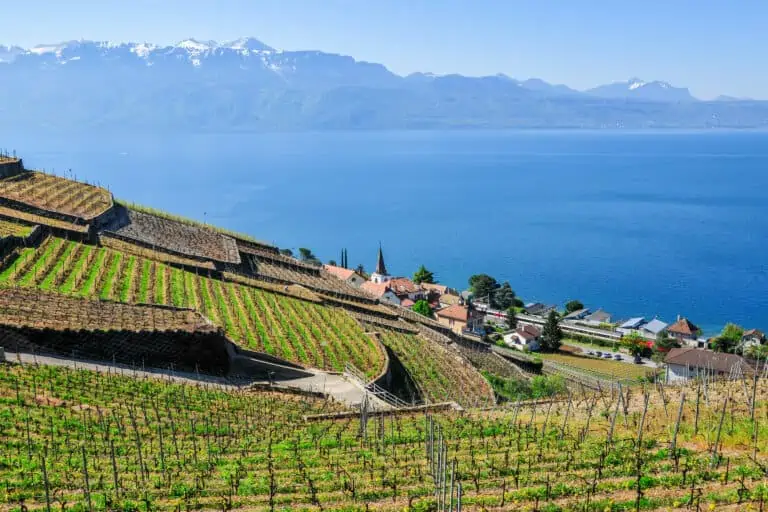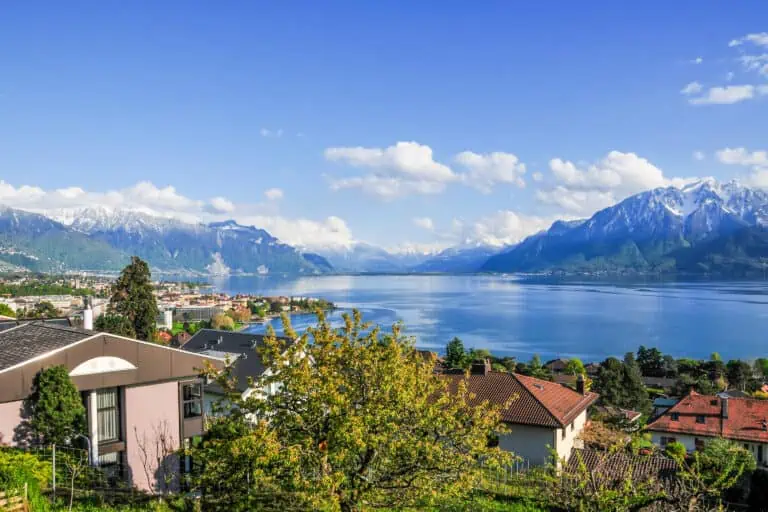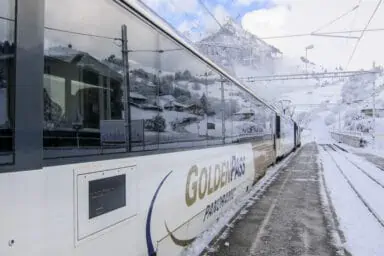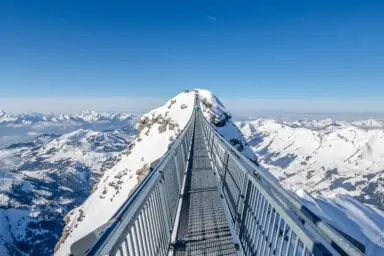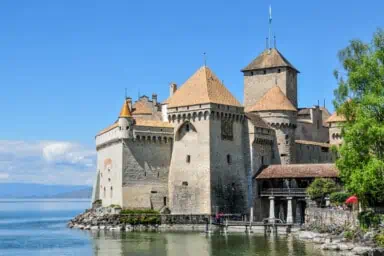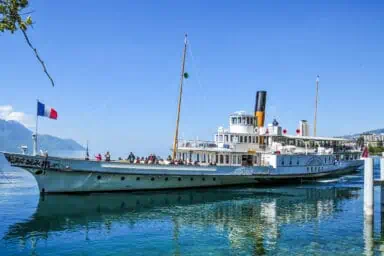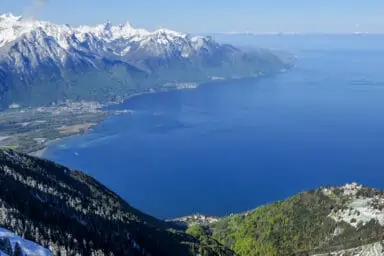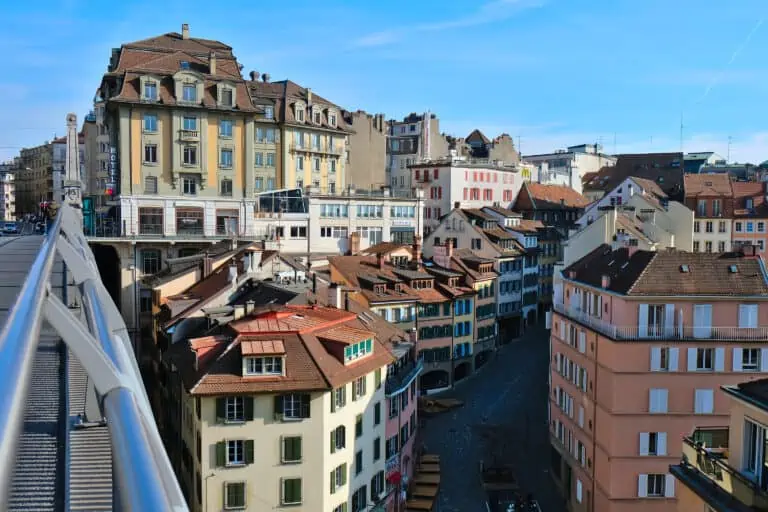What to do in the Lake Geneva region 
The Lake Geneva area offers plenty of activities on and near the lake. Excursions to other regions are possible too: the French Mont Blanc region, other parts of the canton of Vaud, the Fribourg area, and south-western Bernese Oberland.
What not to miss
We recommend including at least these activities in your Lake Geneva itinerary:
- Visit one of the main towns: Geneva or Lausanne if you want to explore a larger city, or Montreux if you prefer a mid-size town.
- Make a boat trip on the lake.
- Visit a mountain top in the hills north of the lake, such as Rochers-de-Naye.
The best towns to visit
Apart from famous tourist places such as Geneva, Lausanne and Montreux, we recommend a visit to these lakeside towns:
- Nyon, with several castles and the National Swiss Museum.
- Morges, with a car-free medieval town center where markets are held.
- Lutry, a lovely village in the Lavaux vineyards with a pretty lake promenade.
- Vevey, close to Montreux, with a nice lakefront and several picturesque streets in the town center.
- One of the scenic villages on the southern (French) border of the lake: St. Gingolph (which is partly Swiss and partly French) or Évian-les-Bains for example.
If you want to explore places in the wider lake area, consider the below towns. They're all very pretty and have well-preserved heritage sites:
- Gruyères.
- Fribourg.
- Aigle, with its medieval castle.
- Moudon, with the region's largest parish church.
- Yverdon-les-Bains, with many spa facilities and a castle.
- Towns in the Three Lake-area: Neuchâtel ("Neuenburg" in German), Bienne ("Biel") or Morat ("Murten").
- Villages in the Pays d'Enhaut region, such as Château d'Oex, Rossinière and Rougemont.
Mountains in the Lake Geneva region
Mountain trips can best be made from eastern Lake Geneva. Our recommendations are:
- Rochers-de-Naye above Montreux. A stop at Glion is well worth it: this little resort above Montreux offers wonderful views over the lake.
- Les Pléiades. This train station in the hills can be reached by cogwheel train from Vevey and Blonay. The area is well-known for its daffodils in spring.
- Mont Pèlerin, to be reached by funicular from Corseaux. Try to include a walk to the nearby Plein Ciel tv tower. A lift gets you up to a wonderful viewing platform close to the top of the tv tower.
- Glacier 3000.
- Berneuse above Leysin, with the rotating restaurant "Le Kuklos".
Scenic train rides in the Lake Geneva region
Apart from mountain trains, such as those to Rochers-de-Naye and Les Pléiades, there are lots of other scenic train routes in the Lake Geneva region. Some of our recommendations:
- The northern shore of Lake Geneva. We mostly like the hillier segment between Lausanne and Montreux.
- The rides from Lausanne up north: to Fribourg - Bern, and to Yverdon-les-Bains - Neuchâtel.
- The GoldenPass ride from Montreux-Gstaad-Zweisimmen-Interlaken.
- The regional train from Montbovon to Gruyères.
- The steam train ride from Blonay to Chamby.
- The historic culinary ride from Morges to Bière.
Hikes in the Lake Geneva region
The Lake Geneva area is a wonderful hiking region. Due to the mild temperatures, spring sets in early, and temperatures can be great for walking until well into October.
Some of our favorites are:
- Hikes in the regional nature park of Gruyère-Pays d'Enhaut.
- A hike in the Lavaux area, for example Lutry-Epesses.
- An easy lakeside walk, such as Montreux-Veytaux (with the Chillon Castle)-Villeneuve.
- The Chauderon Gorge near Montreux.
Travel info and map 
How to reach Lake Geneva
We recommend using the excellent trains in the Lake Geneva region, and the boats crossing the lake. To us, a car is more of a burden than a useful vehicle here. This especially holds for larger cities like Geneva and Lausanne: navigating in busy traffic is challenging and parking costs are high.
If you're in doubt, our comparison of car and train travel may help.
Directions to Lake Geneva
If you arrive in Geneva, for example by plane or by TGV from Paris, you're right on the lake.
If you enter Switzerland from other cities, you can simply take a train to your destination on the lake. Examples of traveling times from Zurich and Basel:
- Zurich-Geneva 2h45
- Zurich-Lausanne 2h15
- Zurich-Montreux via Bern and Lausanne 2h40
- Zurich-Montreux via Lucerne and the GoldenPass route 6h30-7h00
- Basel-Geneva 2h45
- Basel-Lausanne 2h15
- Basel-Montreux 2h45
Find specifics for your journey in the Swiss timetable.
How to travel in the Lake Geneva region
Swiss trains take you pretty much everywhere in the Lake Geneva area. The main line runs along the northern lakeshore: between Geneva in the west and Villeneuve in the east.
Other train routes take you north of the lake (to the Jura, Fribourg, and the Three Lakes area of Neuchâtel) and east of it (to the mountain region of Les Diablerets and to the Rhone Valley in the Valais).
Buses to smaller towns complement the train network. Boats cross the lake year-long, although the winter timetable is somewhat limited.
How to reach French areas from Geneva
There are several ways to visit France from Geneva:
- The boats connect the Swiss towns on the northern shore with several French ones on the southern shores.
- In addition, there are regional trains and buses from Geneva to the French villages on the southern lakeside.
- Scenic regional trains get you to the French mountain village of Chamonix-Mont-Blanc in about 2h40.
- There are quick and direct train connections to Paris.
Rail passes for the Swiss parts of Lake Geneva
Passes for all of Switzerland, such as the Swiss Travel Pass, are valid for Lake Geneva too. All train, bus and boat rides are free. Urban transport, for example in Geneva and Lausanne, is included too. Entry to many museums is free. Mountain trips are discounted.
The Swiss Half Fare Card can be used here too: it offers a 50% discount on nearly all trips.
If you book a hotel, campsite, B&B, or holiday accommodation in the Montreux-Vevey area, you'll get a free Montreux Riviera Card. The card allows free local traveling, discounts on traveling in the region, and discounts on local attractions. The Swiss rail passes usually provide better discounts and cover a larger area though.
Rail passes that are valid in France
Note that none of the rail passes mentioned above is valid in France. You'll need full-fare tickets for trips to Chamonix, the French villages on the southern Lake Geneva shore, Paris, and other destinations in France.
A Eurail Global Pass does cover many routes in France. It can be a good choice if you plan a lot of trips in both France and Switzerland.
Use our rail pass guide and tools to find out which pass is best for your plans.
Switzerland map with Lake Geneva
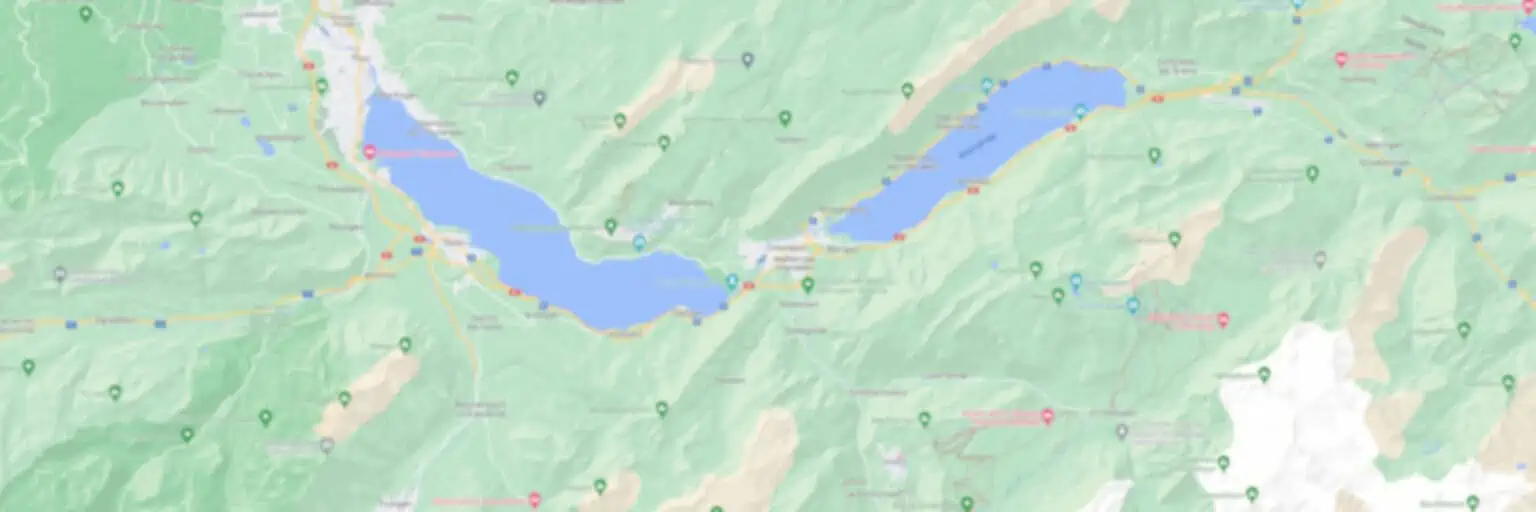
The best months for Lake Geneva 
A good destination in all months
Due to its mild climate, Lake Geneva is a good destination all year. In low-season months, such as March and November, the hills surrounding the lake look least attractive to our taste. But the many excursion options in larger cities like Geneva and Lausanne make up for that.
Spring and fall: our preference
Our personal favorites are spring (April to June) and fall (late September-October). That's because it's likelier to see snow on the mountains surrounding eastern Lake Geneva during these months. And it can get pretty hot in the summer months of July and August. Personally, we prefer somewhat lower temperatures.
Lake Geneva in winter
Lake Geneva isn't the most obvious winter destination. There aren't many mountains in the western lake area. The ones in the east do have snow resorts and ski areas, but as they're at relatively low altitude, they aren't very snow-sure.
Whether or not you can enjoy snow, there are always plenty of museums and cultural activities in larger cities like Geneva and Lausanne.
We do think the area is worth a visit in November and December, as the holiday atmosphere is great in cities and larger villages. Our top pick would be Montreux, because of its wonderful lakeside Christmas market.
Weather in the Lake Geneva region 
What the climate is like
On average, you can expect mild and relatively sunny weather around Lake Geneva. The region is at low altitude to Swiss standards, which also contributes to higher temperatures.
Average temperatures
Daytime temperatures in summer can range from 20°C to 27°C. Temperatures in city centers, such as those of Geneva and Lausanne, are usually a bit higher than in smaller villages and areas with fewer buildings. Heat waves with day temperatures of 30°C to 35°C are no exception either.
Daytime temperatures in winter are mostly far above freezing point: about 5°C to 10°C.
Rain and snow
Rain can occur year-long in the Lake Geneva region. There's more precipitation in summer than in winter on average, but there aren't huge differences. Especially in summer, showers by the end of a warm day are more common than continuous rain all day long.
Don't expect snow in the lakeside cities and villages. It can happen, but Lake Geneva is mostly too low and too warm to receive snow. The hills and mountains near eastern Lake Geneva, and further east in the Valais, will mostly be snowy though, especially in January and February. This still makes for brilliant views!
5-day weather forecast for Lake Geneva
Below is the 5-day weather forecast for Morges, which is more or less half-way between western and eastern Lake Geneva. Always consult a specific local forecast for your destination, as there can be regional differences.
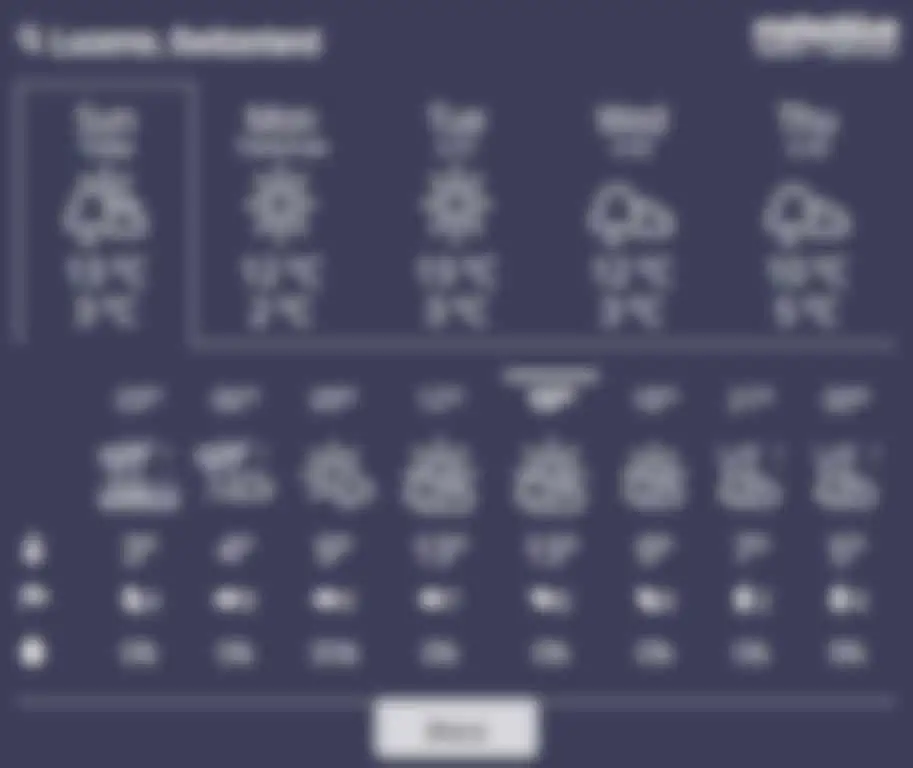
Accommodation in the Lake Geneva area 
In our experience, Lake Geneva offers fewer holiday rentals than some other Swiss tourist areas such as the Bernese Oberland and the Valais. You'll certainly be able to find apartments though, and there's an excellent choice of hotels in the entire region.
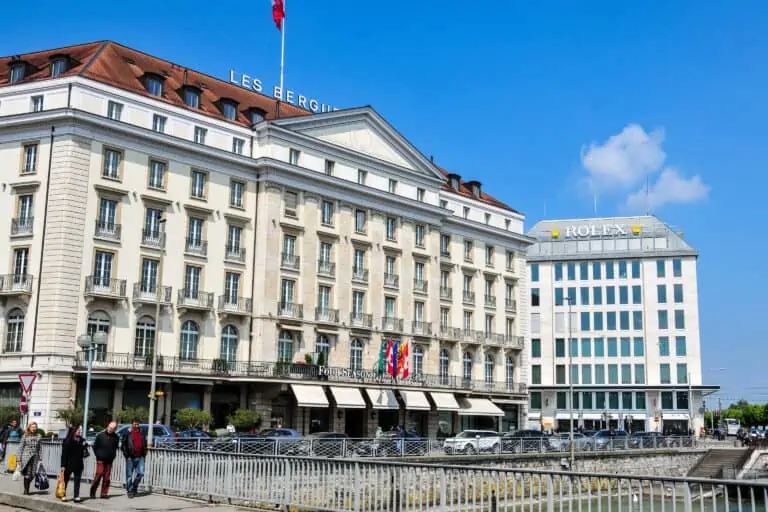
Find your hotel in Geneva, Switzerland
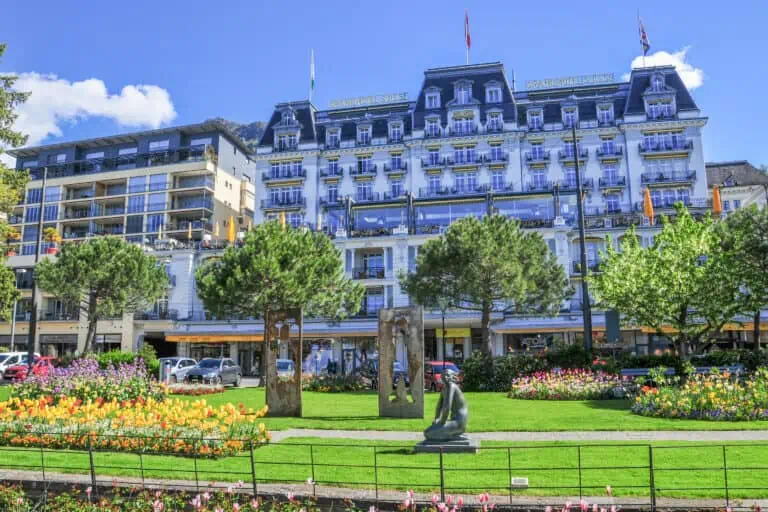
Hotels in Montreux, Lake Geneva
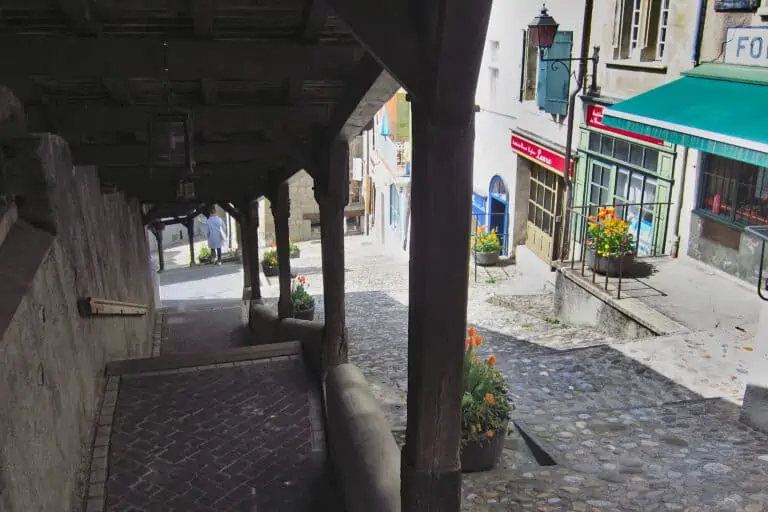
Find your hotel in Lausanne on Lake Geneva
What to expect in western Lake Geneva
Towns and scenery
Western Lake Geneva is located between the vibrant cities of Geneva and Lausanne, which are both among the larger cities of Switzerland. The north-western shores along this part of the lake are highly populated, with gentle hills.
Types of activities near Geneva
Mountain trips in the immediate vicinity of Geneva are scarce, as the landscape is relatively flat here. If you’re looking for more diverse scenery and day trips into the Alps, we recommend considering the eastern part of Lake Geneva instead.
The surroundings of Geneva are mainly suitable for city trips, boat rides over the lake and visits to the charming towns along the northern (Swiss) shores and the southern (French) shores.
Other French destinations, such as Annecy and the Chamonix-Mont-Blanc region, can be reached from Geneva too.
North-western Vaud, the Jura and the Three Lakes area
Geneva and Lausanne also provide good access to the northern area of the canton Vaud (called “Waadtland” in German). For example, you can pay a visit to the attractive town of Yverdon-les-Bains, with its spa facilities and its many historic heritage sites.
It’s also easy to reach the wonderful Jura region and the so-called ‘Three Lakes’ area with the towns of Neuchâtel (“Neuenburg” in German), Bienne (“Biel”) and Morat (“Murten”).
What to expect in eastern Lake Geneva
Towns and scenery
The main towns on eastern Lake Geneva are Lausanne, Vevey and Montreux. They’re all connected by train: it’s just 20 minutes between Lausanne and Montreux.
The landscape is much more hilly than around western Lake Geneva. The slopes directly on the lake are full of pretty villages and vineyards. Further up north and east, the hills turn into mountains. In fact, east of Lausanne is where the Swiss Alps begin.
The Lavaux vineyards
The Lavaux area, between Lausanne and Montreux, is known for its photogenic vineyard terraces. Vineyards are not exclusive to this area of Switzerland. They can be found elsewhere in the country too, wherever there are sunny south-facing slopes. But these terraces with their wonderful lake views are unique enough to be listed as UNESCO World Heritage.
The Swiss Riviera
The area of Vevey and Montreux is also referred to as the ‘Swiss Riviera’. If you like luxury shopping, upper-class hotels and sunny boulevards on the lake, this is where you should be heading.
Fribourg and eastern Vaud
Fribourg and Gruyères, north of the lake, can be well reached from Montreux and other towns on eastern Lake Geneva.
South-western Bernese Oberland
If you’re based in or near Montreux, it’s easy to pay a visit to Gstaad, Saanen and the Simmen Valley in the south-west of the Bernese Oberland. Just hop on one of the GoldenPass trains for a scenic journey north.
Where to stay on Lake Geneva
We think these are the best resorts for your holidays in the Lake Geneva region:
- Spend one or several days in Geneva if this is where you arrive in Switzerland or where you depart. The city is absolutely worth your time, and it’s easy to continue your journey once you’ve explored the town center and the lake. If you’re interested in the French Mont Blanc region, Geneva is a good base too.
- Base yourself in Lausanne if you want to be located centrally on the lake. You can travel in the directions of both Geneva and Montreux. Boat trips to both sides of the lake depart here. And it’s easy to travel to towns in the north: Fribourg, Neuchâtel or Bern for example. The vineyards of Lauvaux are at your doorstep too.
- Stay in Montreux if you prefer a mid-size town on the lake, and if you want to enjoy mountain trips and excursions to the Lavaux vineyards.
- Consider Vevey as a slightly less chic, but more affordable alternative to Montreux.
Lake Geneva FAQ
-
How big is Lake Geneva?
Lake Geneva is Switzerland’s largest lake. It stretches out from Geneva in the west to Villeneuve in the east. A train ride between these towns, along the northern shore, takes 1h20.
-
Why is Lake Geneva in Switzerland popular?
Lake Geneva is a famous holiday region because of its mild and sunny climate. It’s also home to the famous cosmopolitan city of Geneva, the vibrant boulevard of Montreux, and the splendid vineyards of the Lavaux area.
-
What’s correct: Lake Geneva, Lake Léman or Lac Léman?
“Lake Geneva” is the English name for this Swiss lake. Its original French name is “Lac Léman”. In German, it’s called “Genfersee”.
Sometimes the names “Lac Léman” or “Lake Léman” are used in English too, to distinguish it from the American Lake Geneva in the state of Wisconsin.
Other websites of interest
- www.montreuxriviera.com: Montreux Riviera Card
- en.chamonix.com: Chamonix-Mont-Blanc Tourism
- www.myvaud.ch: Vaud/Waadtland Tourism
- www.myvaud.ch: the Lavaux Vineyards
- www.j3l.ch: Jura and Three Lakes Tourism
- www.gruyerepaysdenhaut.ch: the regional park Gruyère-Pays d'Enhaut
- www.montreuxriviera.com: the Chauderon Gorge
- www.myvaud.ch: Blonay-Chamby steam train
- www.morges-tourisme.ch: Morges-Bière historic train
More about the Lake Geneva cities and towns 
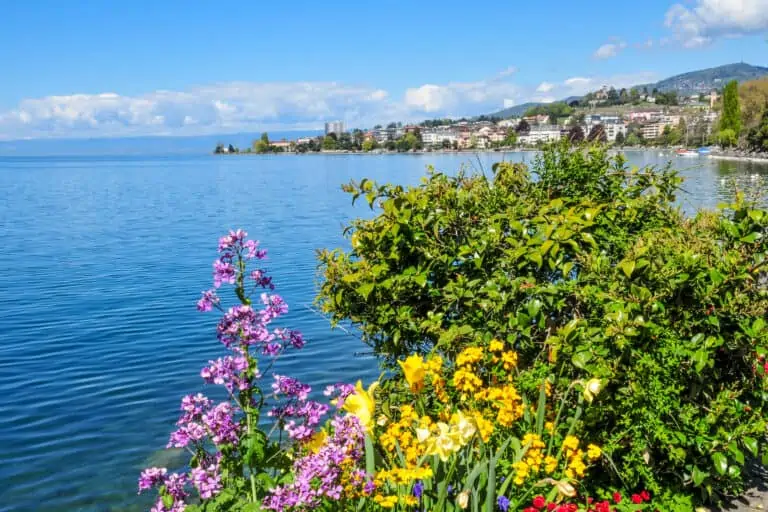
Montreux
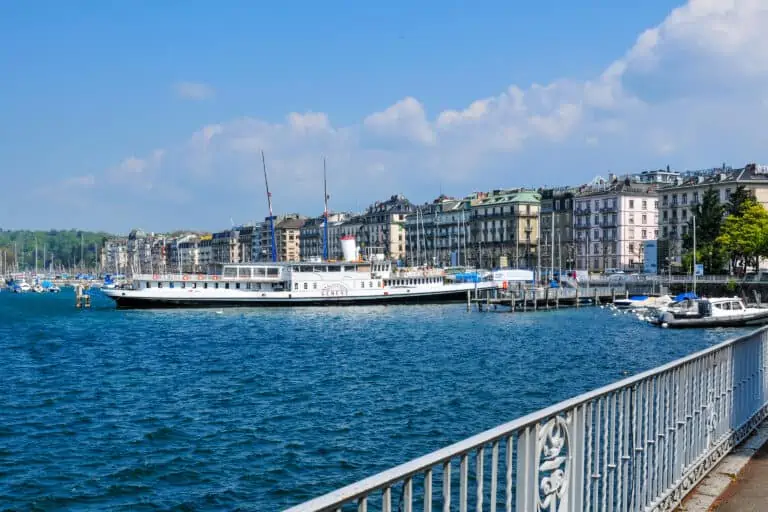
Geneva
Itineraries that include Lake Geneva 
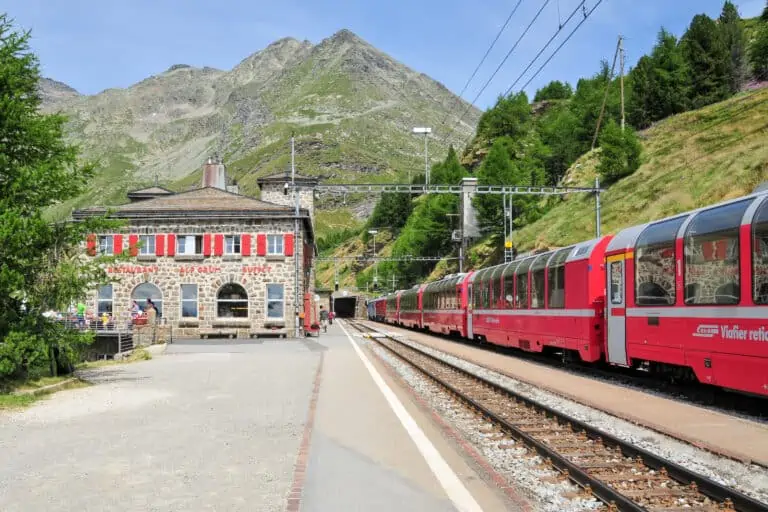
Ultimate scenic trains
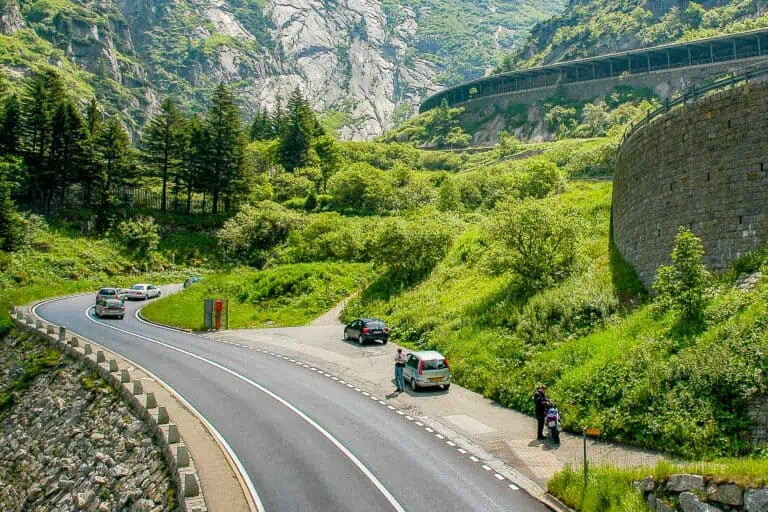
Pass road tour
What we write about Lake Geneva in our blog 
